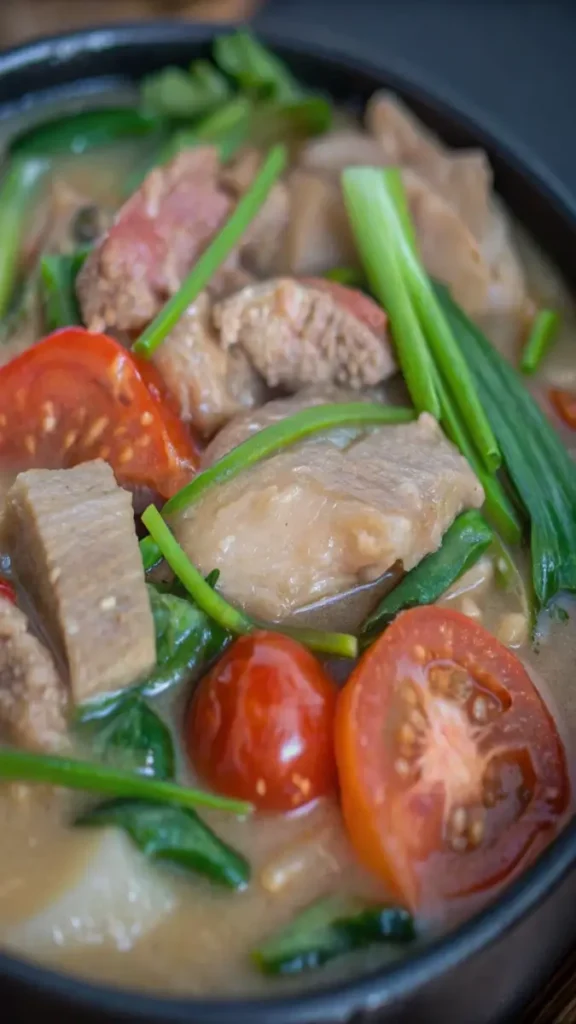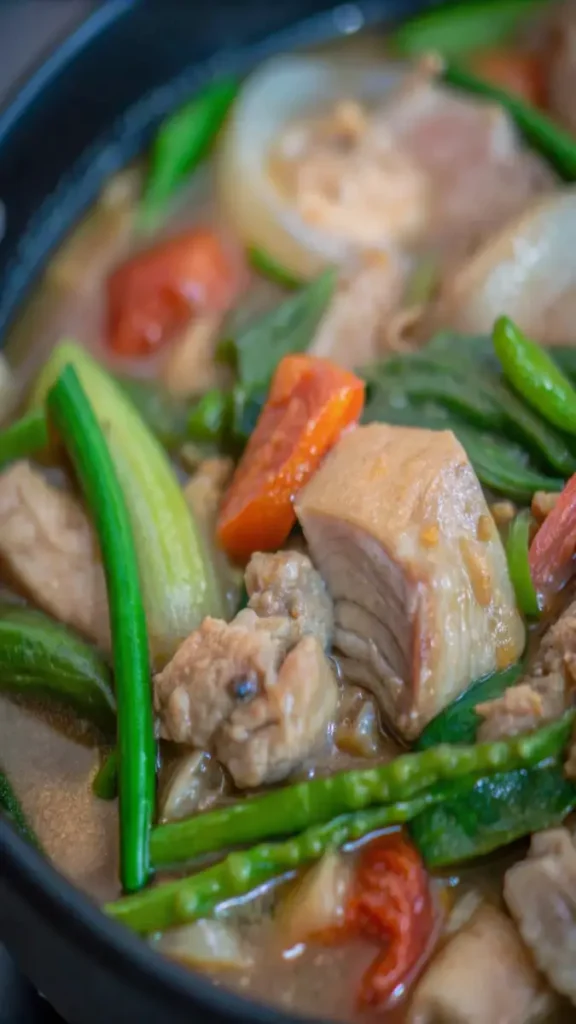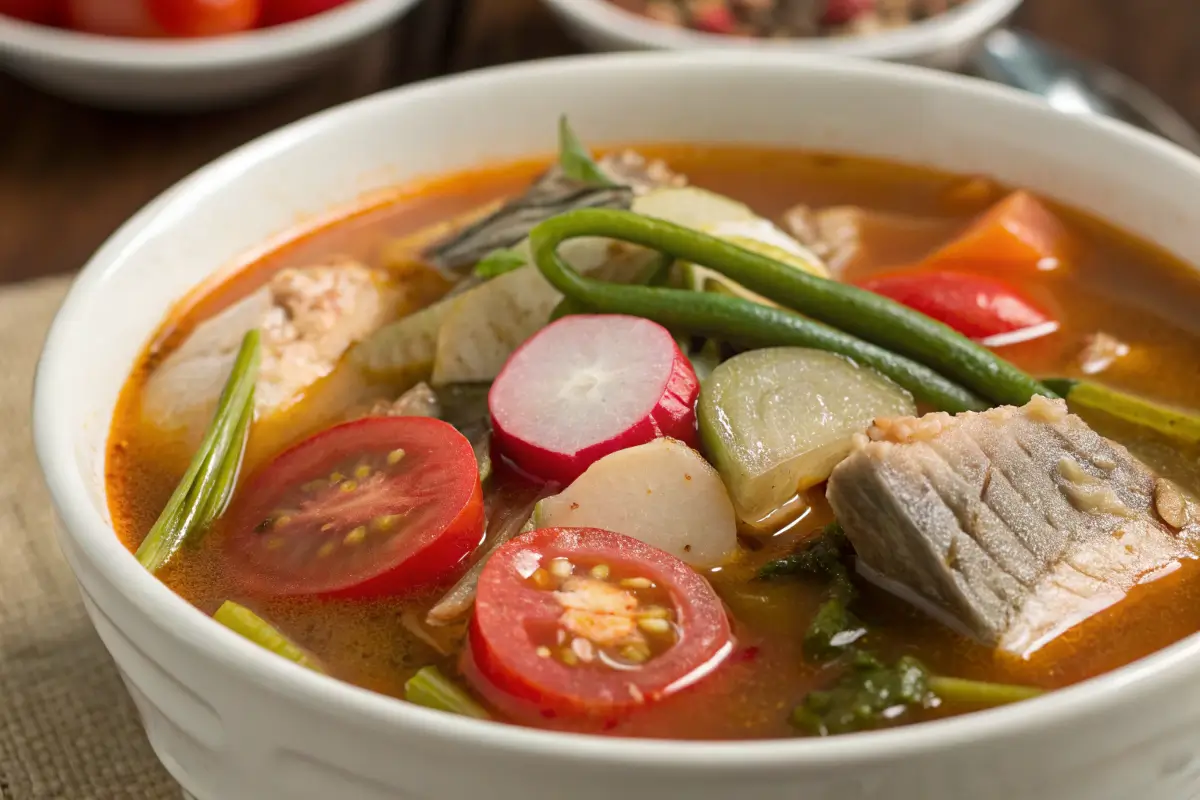Sinigang Recipe: A Perfectly Tangy Filipino Comfort Food
If there’s one dish that defines comfort food for Filipinos, it’s sinigang. This tangy and savory soup is a staple in Filipino households, and for good reason—it’s hearty, flavorful, and filled with fresh ingredients. Whether you’re new to Filipino cuisine or you grew up eating sinigang at every family gathering, this recipe will bring warmth to your table.
In this post, we’re diving into everything you need to know about making sinigang, from choosing the right ingredients to customizing it to your taste. So grab your apron and get ready to cook one of the most iconic dishes in the Philippines!
What Is Sinigang Recipe?
Sinigang (pronounced “see-nee-gahng”) is a sour soup that’s all about balance. Its signature tang comes from tamarind, but other souring agents like calamansi, green mango, or kamias are sometimes used. The soup is traditionally made with pork, but you’ll also find versions with shrimp, fish, or even beef.
What makes sinigang so special? It’s the perfect mix of sour, savory, and umami flavors, paired with fresh vegetables and tender meat. And let’s not forget—it’s the ultimate rainy-day dish, warming you up from the inside out.
Sinigang Recipe Ingredients
Here’s what you’ll need to make a classic pork sinigang:
For the Soup:
- Pork belly (liempo) – 1.5 lbs, cut into chunks. Pork ribs are also a great option.
- Tamarind mix – 1 packet (or fresh tamarind if available).
- Water – 8 cups.
- Tomatoes – 2 medium, quartered.
- Onion – 1 medium, sliced.
- Radish (labanos) – 1 small, peeled and sliced.
- Eggplant – 2 medium, cut into chunks.
- String beans (sitaw) – A handful, cut into 2-inch pieces.
- Kangkong (water spinach) – 1 bunch. Substitute spinach if unavailable.
- Okra – Optional, for added texture.
- Green chili peppers (siling pangsigang) – 1–2 pieces, for a mild heat.
Seasoning:
- Fish sauce (patis) – 2–3 tbsp, to taste.
- Salt and pepper – To taste.
How to Make Sinigang Recipes
Step 1: Boil the Pork
Start by boiling the pork in a large pot with 8 cups of water. Skim off the scum that rises to the surface for a clear broth. Add the onion and tomatoes, and let it simmer for about 45 minutes or until the pork is tender.
Step 2: Add Vegetables
Once the pork is tender, add the radish and cook for 5 minutes. Follow with the eggplant, string beans, and green chili. Let everything simmer for another 5–7 minutes.
Step 3: Add Tamarind Mix
Dissolve the tamarind mix in a small amount of water, then pour it into the pot. Stir well and taste the soup. Adjust the sourness by adding more tamarind mix if needed.
Step 4: Add Kangkong
Finally, toss in the kangkong leaves. Turn off the heat and let the residual warmth soften the greens.
Step 5: Season and Serve
Season the soup with fish sauce, salt, and pepper. Serve hot with steamed white rice.
Tips for the Best Sinigang recipe
- Use Fresh Tamarind
If you can get your hands on fresh tamarind pods, use them for an authentic flavor. Boil the pods in water, mash the pulp, and strain out the seeds. - Choose the Right Pork
Pork belly is classic for its rich flavor, but pork ribs or even pork shoulder work well if you prefer a leaner cut. - Don’t Overcook the Vegetables
Add the veggies in stages to keep them from getting mushy. The greens should always go in last. - Customize the Souring Agent
While tamarind is traditional, calamansi juice or even green mango slices can be used for a unique twist. - Add Heat If You Like
If you love spicy food, add more green chilies or a dash of chili flakes.

Variations of Sinigang
Sinigang Recipe is incredibly versatile. Here are some popular variations you can try:
1. Shrimp Sinigang Recipe (Sinigang na Hipon)
Swap the pork for shrimp and adjust the cooking time—shrimp cooks much faster than meat. This version is lighter and perfect for seafood lovers.
2. Beef Sinigang Recipe (Sinigang na Baka)
Beef shank or short ribs are great for this hearty version. It takes longer to cook, but the tender beef and rich broth are worth the wait.
3. Fish Sinigang Recipe (Sinigang na Bangus)
Milkfish (bangus) is commonly used for fish sinigang recipe, but you can also use salmon or tilapia. This version is tangy and refreshing.
4. Vegetarian Sinigang
Make it meat-free by using tofu and loading up on vegetables. Just use vegetable stock as your base.
More delicious recipes. Check these out!
Health Benefits of Sinigang Recipe
Sinigang isn’t just delicious—it’s also packed with nutrients.
- Rich in Vitamins: The vegetables in sinigang recipe are loaded with vitamins A, C, and K.
- Low in Calories: It’s a light, broth-based dish, making it a great option for healthy eating.
- Good for Hydration: The tangy broth keeps you hydrated, especially on hot days.
- Comfort Food for Cold Days: The warmth of the soup is perfect for soothing colds and sore throats.
FAQs About Sinigang Recipe
Can I make sinigang without tamarind?
Yes! You can use alternatives like calamansi juice, green mango, or even lemon juice. Tamarind gives it the signature flavor, but experimenting is part of the fun.
What can I serve with sinigang?
Sinigang is best paired with steamed white rice. You can also serve it with crispy fried dishes like fried fish or lumpia for a textural contrast.
How long does sinigang last in the fridge?
Sinigang can be stored in the fridge for up to 3 days. Reheat it gently on the stove, and don’t forget to add fresh greens when reheating to keep it vibrant.
Can I freeze sinigang?
You can freeze the soup (without the greens) for up to a month. Add fresh vegetables when you’re ready to reheat it.
Is sinigang gluten-free?
Yes, as long as your fish sauce and tamarind mix don’t contain added gluten. Always check the labels!
A Little Story About Sinigang Recipe
When I was a kid, sinigang nights were always my favorite. My mom would simmer the soup all afternoon, and the whole house would smell like tamarind and garlic. She always made it extra sour because that’s how my family liked it—so sour it made you squint with every sip!
Now, as an adult, making sinigang is like a warm hug from my childhood. It’s one of those dishes that feels like home, no matter where you are.
How to Choose the Best Tamarind for Sinigang
When it comes to the sour punch of sinigang recipe , tamarind is the heart and soul of the dish. But did you know there are different ways to incorporate tamarind into your sinigang?
- Fresh Tamarind Pods: These are ideal if you want the most authentic flavor. To use fresh tamarind, boil the pods in water until soft, mash the pulp, and strain out the seeds. The result is a fresh, natural tang that takes your sinigang to the next level.
- Tamarind Paste: A convenient option, especially for those outside the Philippines. Tamarind paste is widely available and easy to use—just dissolve it in water and add to your broth.
- Tamarind Mix (Sinigang Powder): This is the go-to choice for busy home cooks. It’s pre-mixed with spices, making it a quick and foolproof way to get that signature sour flavor.
No matter which tamarind option you choose, the key is to taste as you go. The perfect level of sourness is a matter of personal preference!
Creative Twists on the Classic Sinigang Recipe
While traditional sinigang recipe is already a masterpiece, there’s no harm in putting your own spin on it. Here are some creative ideas to shake things up:
- Sinigang with Roasted Tamarind: For a deeper, smokier flavor, roast fresh tamarind pods before boiling them. This adds a subtle caramelized note to the broth.
- Coconut Milk Sinigang: Add a splash of coconut milk for a creamy twist. This version is especially popular in southern parts of the Philippines.
- Seafood Medley Sinigang: Combine shrimp, fish, squid, and clams for a seafood-packed sinigang that’s bursting with flavor.
- Sinigang na Corned Beef: A modern take that uses tender, slow-cooked corned beef for a unique and hearty dish.
These variations prove that sinigang is as versatile as it is delicious, making it the perfect dish to experiment with.
Why Sinigang Is Perfect for Every Season
While sinigang recipe is often thought of as a rainy-day dish, it’s actually perfect year-round.
- Rainy Days: Nothing beats a steaming bowl of sinigang on a cold, wet day. Its warmth and tangy flavor are the ultimate comfort.
- Hot Summer Days: Believe it or not, sinigang is also refreshing during hot weather. The sourness of the soup helps cool you down, especially when paired with light seafood versions.
- Holiday Gatherings: Sinigang is a staple at family get-togethers. It’s hearty enough to feed a crowd, and its familiar flavors bring everyone together.
No matter the season, sinigang always hits the spot.
More delicious recipes. Check these out!

The Science Behind Sinigang’s Tangy Flavor
Ever wonder why sinigang’s sour flavor is so addictive? It turns out there’s some science behind it!
Sourness activates specific taste receptors on your tongue, which can trigger salivation and improve your appetite. That’s why a sour dish like sinigang is so satisfying—it literally makes your mouth water!
Additionally, the balance of flavors in sinigang recipe (sour, salty, and savory) creates a harmonious blend that keeps you coming back for more. It’s a dish that’s as delicious as it is scientifically fascinating.
Perfect Side Dishes to Pair with Sinigang Recipe
While sinigang is often a meal in itself, pairing it with the right side dishes can make your meal even better. Here are some popular options:
- Crispy Pata or Lechon Kawali: The crunchy, savory flavor of fried pork is the perfect complement to the tangy broth of sinigang recipe.
- Grilled Fish: A simple grilled fish adds a smoky, earthy flavor that balances the soup.
- Steamed White Rice: This is a must—sinigang isn’t complete without rice to soak up the broth.
- Pinakbet: A vegetable dish like pinakbet pairs beautifully with sinigang, adding another layer of healthy, flavorful veggies to your meal.
- Fried Tofu: For a vegetarian-friendly pairing, crispy fried tofu is a great option that adds protein and texture.
These sides not only complement sinigang but also turn your meal into a true Filipino feast.
How to Store and Reheat Sinigang Recipe
If you have leftovers (lucky you!), storing and reheating sinigang recipe is easy.
- Storage: Let the soup cool completely before transferring it to an airtight container. Store it in the refrigerator for up to 3 days.
- Reheating: Heat the soup on the stovetop over medium heat until warmed through. If the vegetables have softened too much, you can toss in fresh ones during reheating.
- Freezing: Sinigang can be frozen for up to a month, but leave out the greens before freezing. Add fresh greens when you reheat it to preserve their texture.
Proper storage ensures your sinigang tastes just as good (if not better) the second time around!
Final Thoughts
Sinigang is more than just a soup—it’s a comforting, nostalgic dish that brings people together. Whether you’re making it for the first time or perfecting your family recipe, there’s no wrong way to enjoy sinigang.
So gather your ingredients, invite your loved ones, and get cooking. One sip of this tangy, hearty soup, and you’ll see why sinigang is beloved by so many.
Let me know how your sinigang turns out—and if you add your own twist, I’d love to hear about it! 😊
